2020 Transition Scout
Geometry: See below
Wheel Size: 27.5′′
Travel: 140 mm rear / 150 mm front (or 150 mm rear with a 62.5 mm stroke shock, up from the stock 57.5 mm)
Stated Weight
- Frame w/ Shock: 3.20 kg / 7.05 lbs
- Complete X01 Build: 13.79 kg / 30.4 lbs
MSRP:
- Frame w/ Fox Float X2 Performance Elite Shock: $3199
- Sram NX Complete: $4499
- Sram GX Complete: $5499
- Sram XO1 Complete: $6599
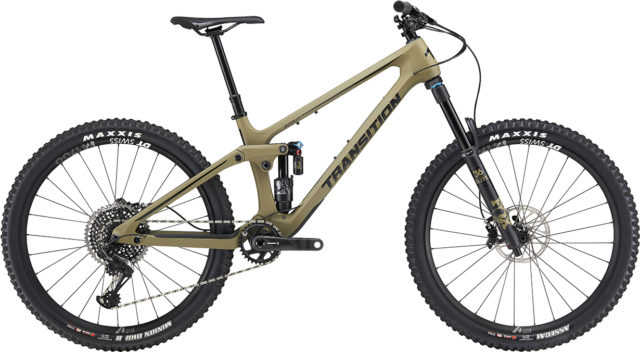
Intro
The Scout has been in Transition’s lineup since 2015, first appearing as a 125mm rear / 140mm front travel Trail bike with 27.5 wheels, but Transition’s press release begins by calling the new Scout “our modern day take on the Bottlerocket” – referencing a bike that they haven’t made since 2012, and one that was marketed as a Slopestyle bike at the time, rather than a Trail bike.
The point Transition is making here is to emphasize that they wanted the Scout to be fun, and in their release video (see below), they call it “the most fun bike in our lineup”. The Bottlerocket was, in its day, a very burly, playful, 140mm-rear-travel bike that rode a lot more like a dirt jump bike given a bunch of suspension than it did like most other ~140 mm bikes at the time, which, when it was first released in 2006, tended to feel more derived from XC bikes.
I owned a first-generation Bottlerocket, and used it for everything from trail rides to hitting dirt jumps to a bit of lift-served DH duty, and for the time it was a remarkably versatile bike, and one that felt far more playful and freeride-oriented than a lot of other bikes in the same travel range. The idea of a modernized version sounds great, so does the new Scout really fit the bill? Let’s look closer.
The Frame
The updated Scout is offered in five sizes, XS through XL, and comes in a carbon frame only, a departure from the last bike, which was only offered in aluminum. The outgoing iteration of the Scout had grown to 130 mm rear / 150 mm front travel, and this latest adds another 10 mm – or 20 mm, if you swap in a longer-stroke shock – to the prior generation. Overall, the lines of the bike carry over from the prior version, with a Horst-link suspension layout, and a vertically oriented shock, which leaves ample room for a water bottle in the front triangle, along with what Transition calls an “accessory mount” under the top tube.
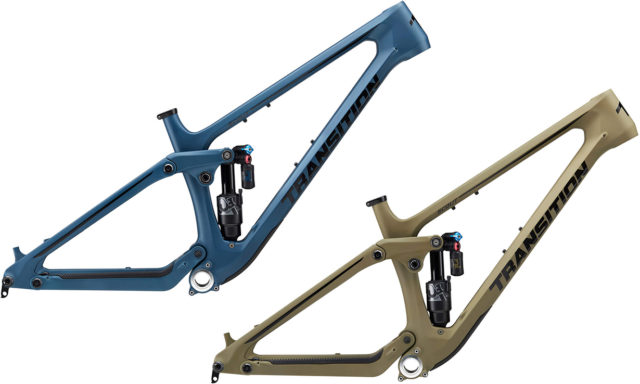
The new Scout frame features a threaded bottom bracket, molded rubber chainstay and downtube protectors, and internal routing for the dropper post and rear derailleur, but an externally routed rear brake, in a nod to ease of routing for the hydraulic line.
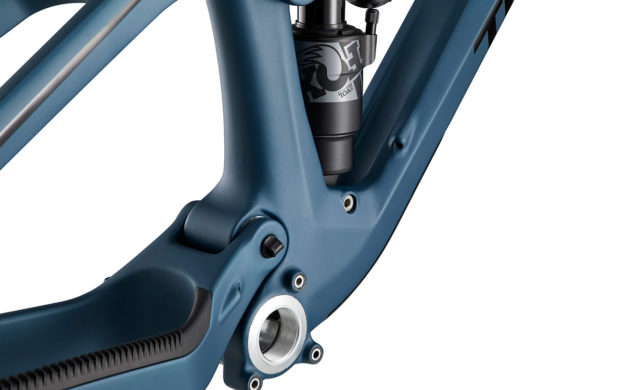
Transition is also quick to point out that the Scout has room for very long dropper posts, with a short seat tube that allows for deep insertion. XS complete bikes come with a 120mm-travel dropper, while Smalls get a 150 mm stroke, M builds get 180 mm, and the L and XL get a monster 210 mm.
While the general suspension layout is carried over from the earlier iterations of the Scout, the new bike is considerably more progressive than the outgoing model. Transition’s published leverage curves show a fairly straight leverage curve in both 140mm- and 150mm-travel configurations, from about 2.85:1 at topout, to 2.15:1 at the end of stroke.
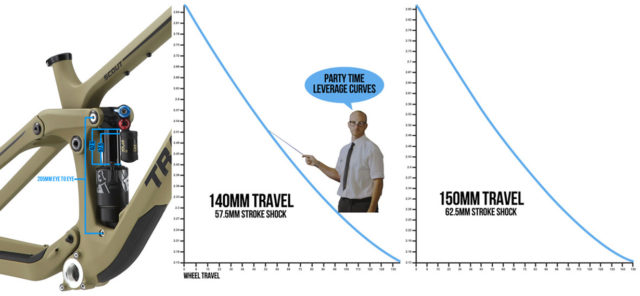
[As an aside, can we, as the bike-literate public, please stop calling bikes with flat leverage curves “linear”? Transition describes the Scout as “linear-progressive”, which is far more descriptive terminology. It’s both progressive, and a straight line (ish). A curve doesn’t have to be horizontal to be linear.]
Another bit of news from Transition is that they’ll now be offering a lifetime frame warranty to the original owner, and lifetime crash replacement, including for secondhand owners, for all bikes released in 2020 going forwards, starting with the new Scout.
The Builds
The Scout will be offered as a frame only, or in three complete builds, with Sram NX, GX, and X01 drivetrain options.
The base NX build on the Scout comes with a Rock Shox Lyric Select RC and Super Deluxe Select+ handling suspension duties, Sram Code R brakes, and Stan’s Flow rims on Novatech hubs. The GX build upgrades to a Lyric Ultimate and Super Deluxe Ultimate, a Stans Flow S1 Team wheelset, and Code RSC brakes, while the top-spec XO1 build goes to Fox suspension (36 Float Grip 2 Performance Elite fork and Float X2 Performance Elite shock), along with DT Swiss M1700 wheels. All three builds get a OneUp dropper post and a Maxxis Assegai 2.5 Exo+ front / DHR2 2.4 Exo+ rear tire combo.
Fit and Geometry
The Scout keeps Transitions “Speed Balanced Geometry” concept – basically their term for combining a longer reach, slacker headtube angle, steeper seat tube angle, and a short-offset fork – and runs with it a little further than the prior generation. The reach is now 10 mm longer in any given size, (460 mm for the Medium), the headtube angle is now 64° across the board (previously 65°), and the effective seat tube angle is around 1.5-2° steeper, depending on size. All five sizes get 430 mm chainstays, and all the complete bikes come with 37mm-offset forks.
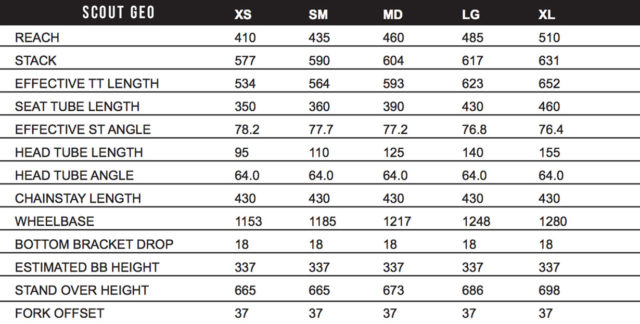
I’m really excited about the geometry on the Scout. It’s definitely on the long/low/slack/aggressive side of things for a 140mm-rear travel bike, but – as I’ve been banging on about for a long time now, and discussed in our recent Bikes and Big Ideas episode on the coming decade – the combination of aggressive geometry with a bit more moderate suspension travel can make for an extremely fun combination of serious capability, blended with a bit more pop and playfulness than you get out of longer-travel, more Enduro race-focused bikes.
That sort of balance is exactly what drew me to the Bottlerocket almost 15 years ago, so maybe Transition is on to something with that comparison. It’s clearly been on their mind of late, as they recently released a video of co-owner Kyle Young riding a 2009 PBR Edition Bottlerocket on some classic trails in British Columbia, including some super sweet skinnies (remember those?).
I’m also glad to see Transition making a thoroughly modern 27.5” bike. In an era where more and more bikes are moving to 29er only, it’s great to have some options sticking around for those of us who still like the snappier handling of smaller wheels.
Some Questions / Things We’re Curious About
(1) Transition talks at length about the Scout being focused on fun, and on paper it does look like a blast. Just how well is that borne out on trail?
(2) Does the Scout mostly make sense as a Trail bike for a rider who’s interested in popping off every little side hit and just riding with a playful style, or with its fairly aggressive geometry, does it have a hard-charging side too? And does it really bring to mind a modernized Bottlerocket?
Bottom Line (For Now)
The updated Scout looks like a super fun, and highly capable mid-travel 27.5 wheeled trail bike, in a landscape dominated by 29ers. The combination of modern Enduro geometry with 27.5 wheels and slightly more moderate suspension travel sounds like an exciting recipe, and I’m very much looking forward to swinging a leg over one. We’re working on getting a test bike to review, so stay tuned for a full review, hopefully coming soon.

Looks like a short travel version of the current Sentinel. Rad!
Matt – It’s the same rear wheel travel as the Sentinel (or more with a longer stroke shock), has different sized wheels, and looks a lot more streamlined/modern than the current Sentinel and Patrol (perhaps angular with the new carbon layup techniques allowing squarer edges). But you’re right with one of your points, it is definitely rad!
Can it be built as a mullet?
To be clear, I’m saying this having not yet ridden the new Scout, but I wouldn’t. To get the same axle to crown height out of a 29er fork as you get out of a 27.5 one, you need to drop the fork travel ~20mm, and having done that, you’re still going to raise the front end a good bit due to the bigger wheel.
If you’re trying to make a mullet out of a non-mullet bike, starting with a 29er lets you get there without messing with the fork travel and/or geometry nearly as much.
I’ve had the 2020 Scout for about a month and it has been pure TNT fun on the trails. My previous bike was a Whyte G170 – a fun, playful Enduro bike. But, it did what an Enduro bike is meant to do – stay planted on the ground (my main beef with the bike was endless peddle strikes going up technical climbs). I knew I wanted a more playful bike. So after looking around I chose the Scout. This bike is built for popping, jumping, and playing. It goes where you put it. But, it is also a very capable bike for ripping down technical, loose trails – it’s a hard charger. The only reason I would go back to a full Enduro bike is if most of my riding was going down steep, rocky, technical trails. Here, an Enduro bike is less fatiguing on the rider. But, I ride a range of trails; and, I feel the Scout is the most playful and capable bike out there.
I can only second Jim’s comment. I got my Scout in early June and have been riding it hard since. I also came from a more burly enduro bike (Banshee Rune 170 mm front / 160 mm rear travel) and wanted a do it all bike that is more playful, but still allows me to let it loose on long, rough alpine descents here in Switzerland, without feeling undergunned. And it does the beautifully.
The versatility is mind blowing. It’s super playful on one hand: snappy in corners, pops extremely well (due to the progressive rear suspension) and loves to get sideways. On the other hand it’s quite stable and composed and I can go really fast without hitting a speed limit. You do need to provide more suspension yourself compared to a full blown Enduro, as the Scout has less and more progressive travel. As Jim said, if the terrain is rough and you’re going fast, you will feel more feedback from the trail. But the Scout manages its travel really well, i.e. doesn’t give it all away instantly and stay quite smooth.
With the long front end and short chainstays it encourages a forward, over the bars riding style, which I love.
You obviously have to be fine with 27.5 wheels, which require more deliberate line choices, but makes the ride more fun and engaging (in my opinion).
The Scout is for somebody who’s main goal are not KOMs, but rather having fun by playing around at mid to fairly high speeds (not as playful at slow speed / flat trails). I truly use it for everything: short after work rides, all day epics, bike park, shuttling. And it never feels out of place.. quite contrary, I have a shit ton of fun on it, no matter where.
For the skiers here.. in my mind the ski analogy to the Scout is the Bibby / Wildcat (184 cm). Same balance of playful / charger personality and good in so many conditions / types of trails. Possibly the 108 version is the better comparison, but haven’t skied that one yet.
Essentially it’s a 27.5er with enduro geometry, but more playful / trailbike like suspension.